Let’s Start at the Beginning
Whatever we’re working on, we tell ourselves a story about it (or there’s a story we would tell about it if asked).
These stories can be pretty simple:
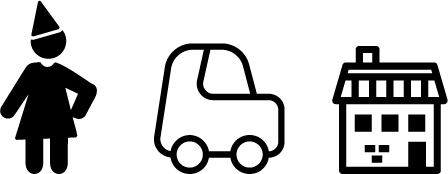
Straightforward stories are like sentences:
- They have a direction, from beginning to end.
- Their different parts are pretty clear.
- They only include what matters to the point of the story.
- They don’t include “unimportant” things (like your cool hat).
We could diagram a work story like this.

But work gets more complicated than that all the time. It can go in a lot of different directions, and have unclear parts.

When that happens, it can be tempting to stick to work that you can describe in a sentence.

Some work just won’t let you do that, though, and our sentences fall apart.

What to do then?
Whatever it is that we do at this point, whatever we call it – it’s a different kind of work entirely than the kind that can fit in a sentence.
A lot of the time, when our story of work falls apart like this, we get annoyed that we can’t figure out the “real work” we’re supposed to be doing. This often makes us feel bad, and is rarely helpful. The Theory is here to say, hey, this is a normal experience, it’s different than straightforward work, and by accepting and articulating it’s weird ways, we can navigate it better.
What the Theory is
The Theory is a way to tell the story of your work while it refuses to fit into straightforward sentences.
It’s a set of related ideas that describe the experience of working on your story of work at the same time as trying to, you know, work on your work.
Taken together, these ideas are meant to help us recognize useful patterns that show up when we’re doing this kind of work.
Most importantly, it gives us a way to organize all those parts in your mind that lets you keep working while they’re all changing and changing each other.
You might already have your own theory or way that really fits your work. Great! The Theory is a general way to look at this kind of work, wherever it appears. Maybe it’ll be helpful to you, maybe not. (I’m hoping it will!)
This is why we capitalize the Theory and not “conceptual labor”– conceptual labor is what we do, and it has a million billion different forms and states and names. The Theory is a specific text that presents a particular way of describing it.
Models
The Theory uses the idea of a mental model to organize all the parts of a work-story that’s gotten out of hand. This is not a new idea, and there’s lots of interesting research about mental models out there.
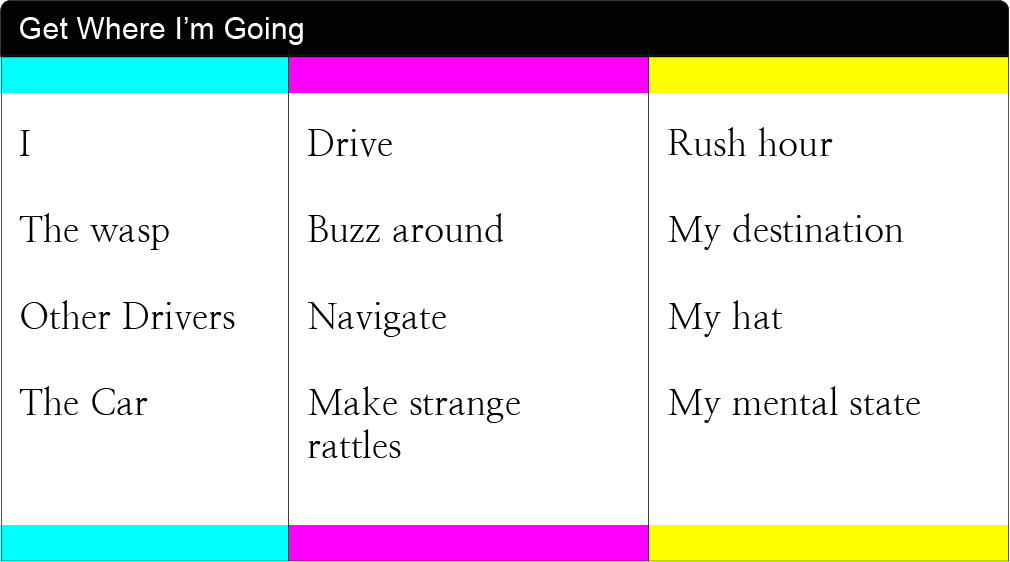
Models in the Theory are pretty simple, and very flexible. They have three types of things in them. Sort of like a sentence:
actorsworkcontext
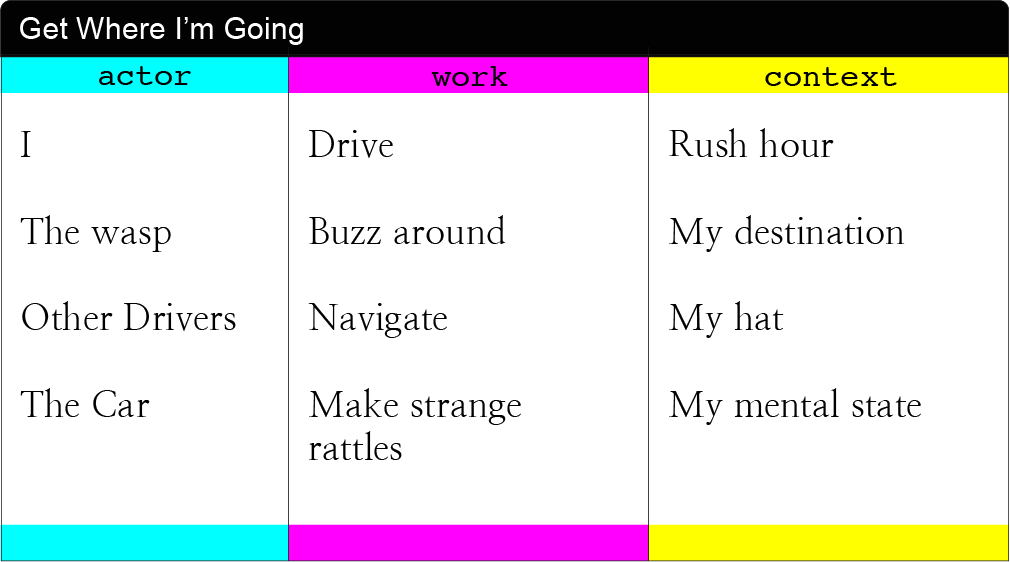
These are all related.
actorsare anything that doesworkworkis what anactorthinks of as workcontextis all the stuff that matters to theactorabout theirwork
Work is really anything you think of as work. Introspection when you’re learning something, taking a walk to change your state of mind, even working on a relationship or caring for someone. As humans, so much of our difficult, worthy, and sophisticated effort doesn’t get to be called Real Work. Hopefully the Theory can change that a little.
A Model lets us make new stories while our experience of work changes
A model is like a story factory – it’s a way to keep track of all the important parts of your experience of work and use them to make different stories about what you’re doing, what it accomplishes, and why you’re doing it. The protagonist of these stories could be yourself, another person, or even a machine like a computer.
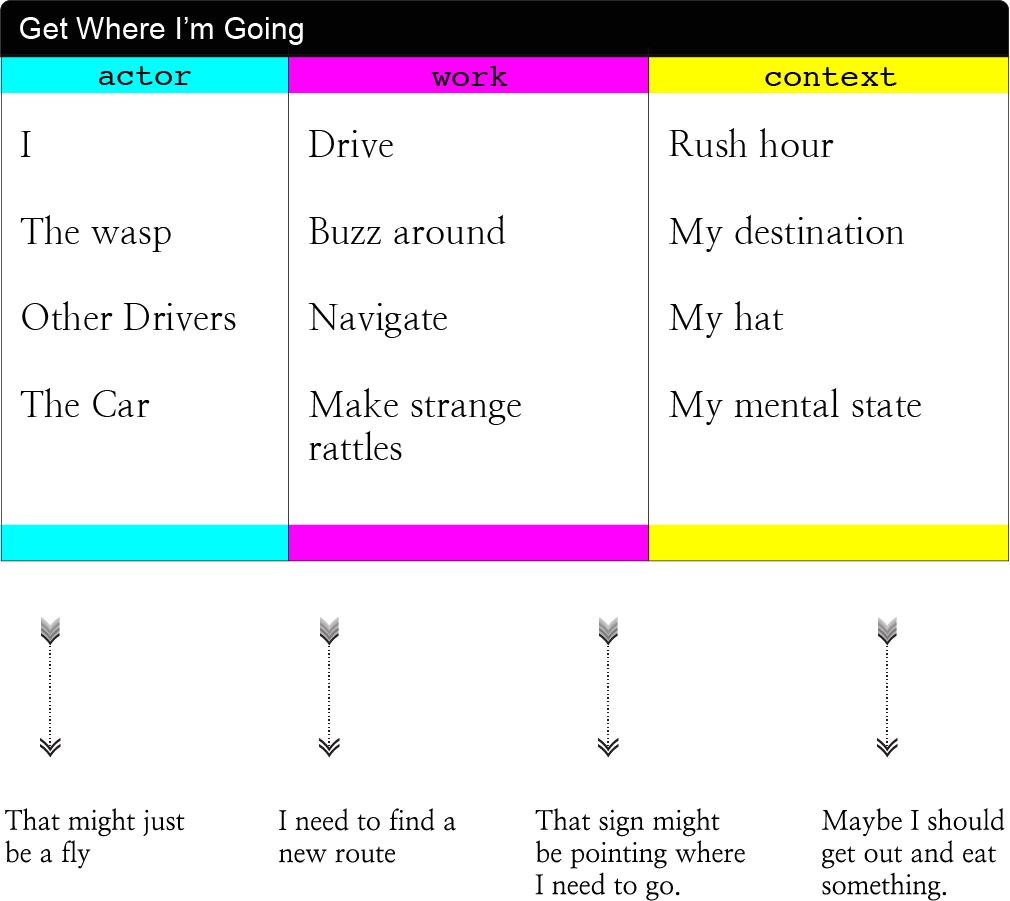
They come from your ideas and feelings about about what’s going on and how to accomplish what you set out to do. On your way to achieving your goal, you can compare, combine, and rewrite all the different stories about work that come out of your model.
Like any factory, your model isn’t a static thing. It has a lot of moving parts that interact with each other
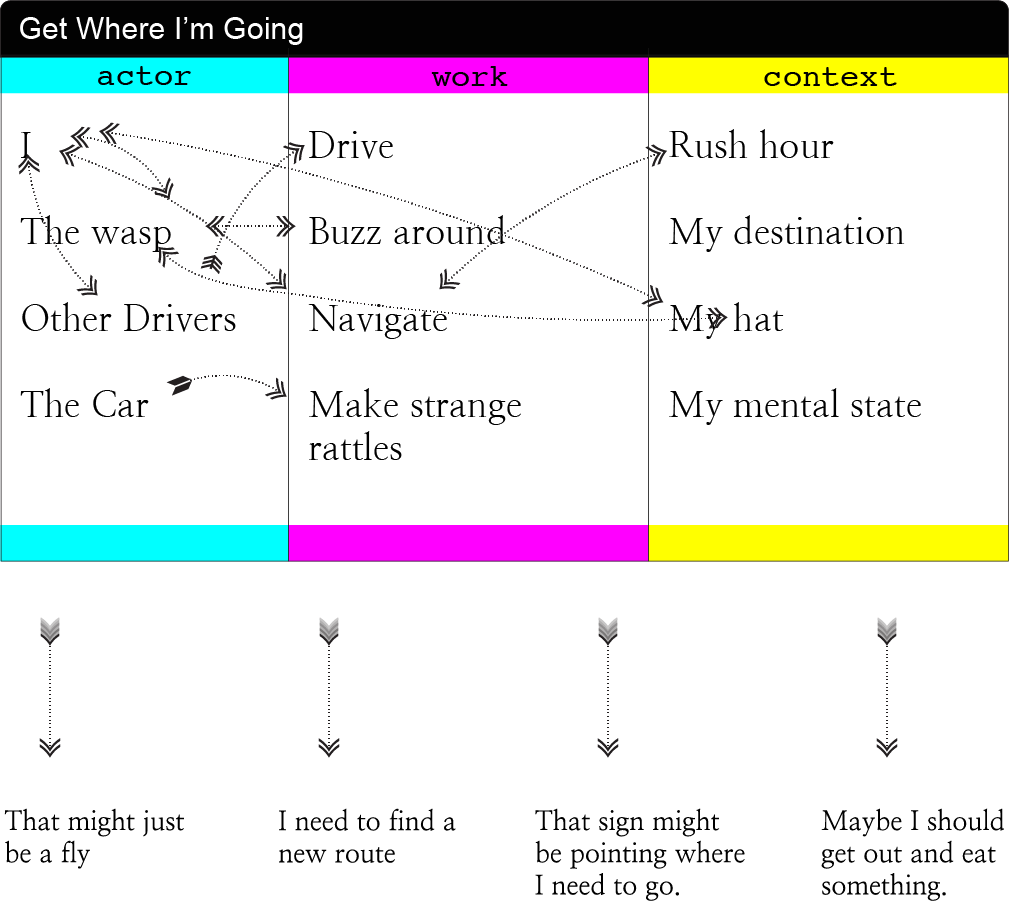
Some of the stories that come out of the model can change the model itself.
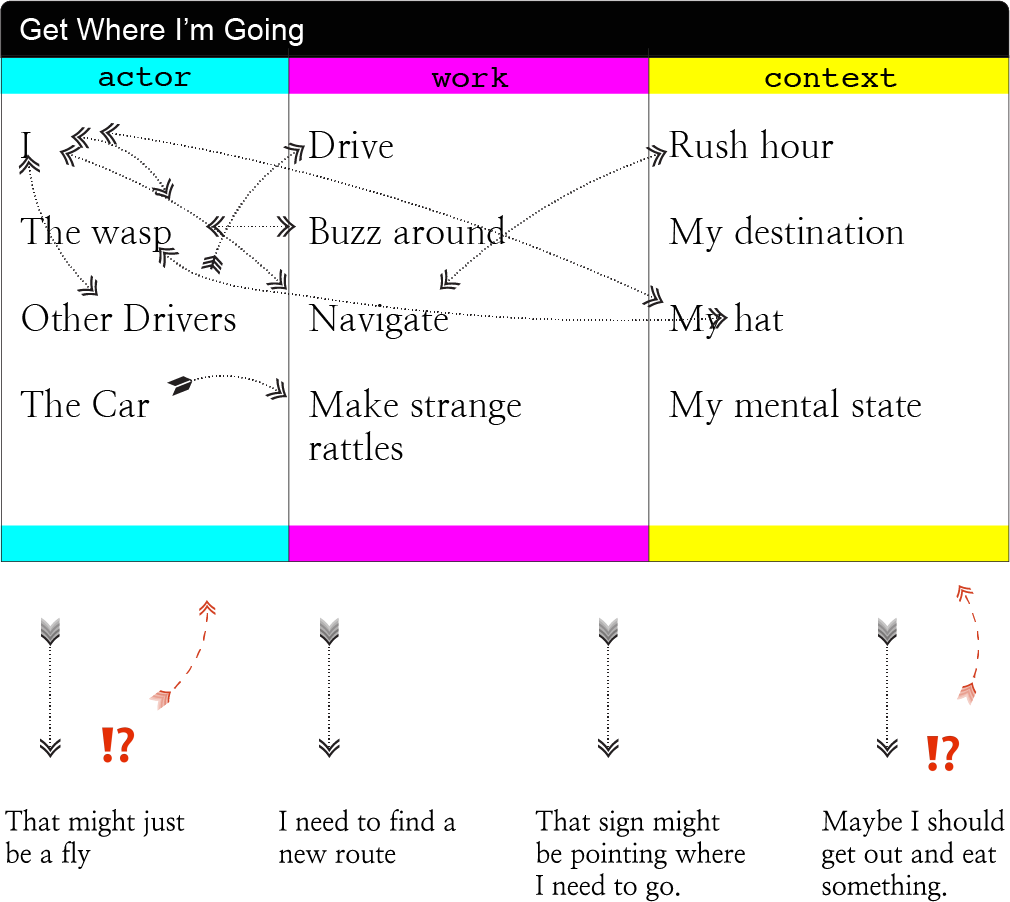
Working towards your goal while also working on the story factory that will help you get there means you’re really doing two kinds of work at once.
If no one else has done what you’re trying to do, or you don’t know enough about what you’re trying to do yet to explain it, there’s probably not one right story about how to do it – good thing you have a story factory.
Big Idea #1 – How to Tell When Your Story is Useless
The useful thing about modeling our work-stories in this way – in fact possibly the most useful thing about the Theory – is that it gives us a way to tell the difference between straightforward work and “this other kind of work.” (Ie conceptual labor). The faster we can do that, the sooner we can stop kicking ourselves for not doing “real work.”
It’s pretty simple:
- When we’re doing normal work, at least one of these parts of the story doesn’t change. The parts of the story are iconic – they don’t come apart, and they have straightforward relationships.

- Work becomes conceptual labor if all of these parts of our story are changing while we do it.
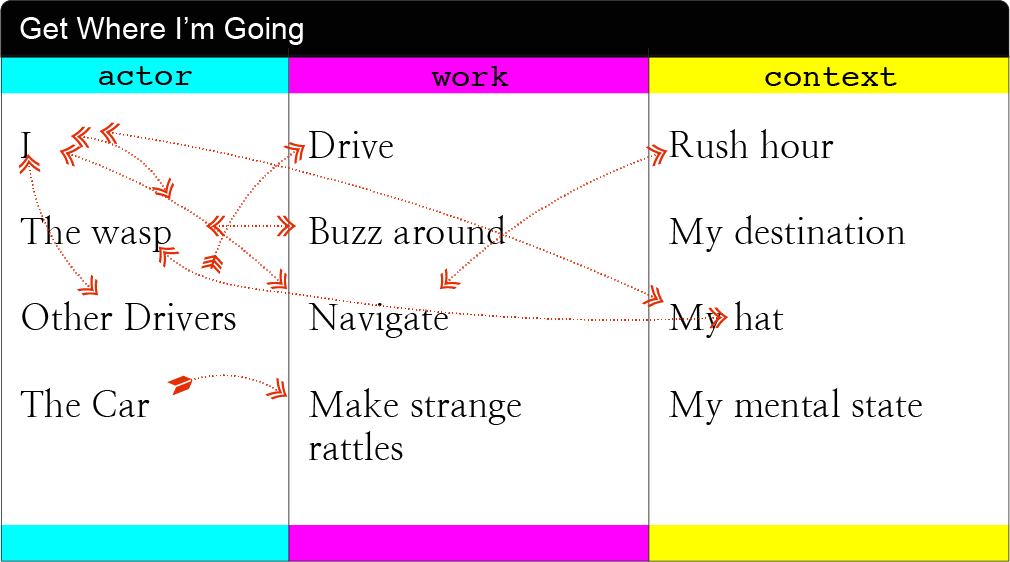
Why? Well, when they’re all changing, we have to work on the story as well as in the story.
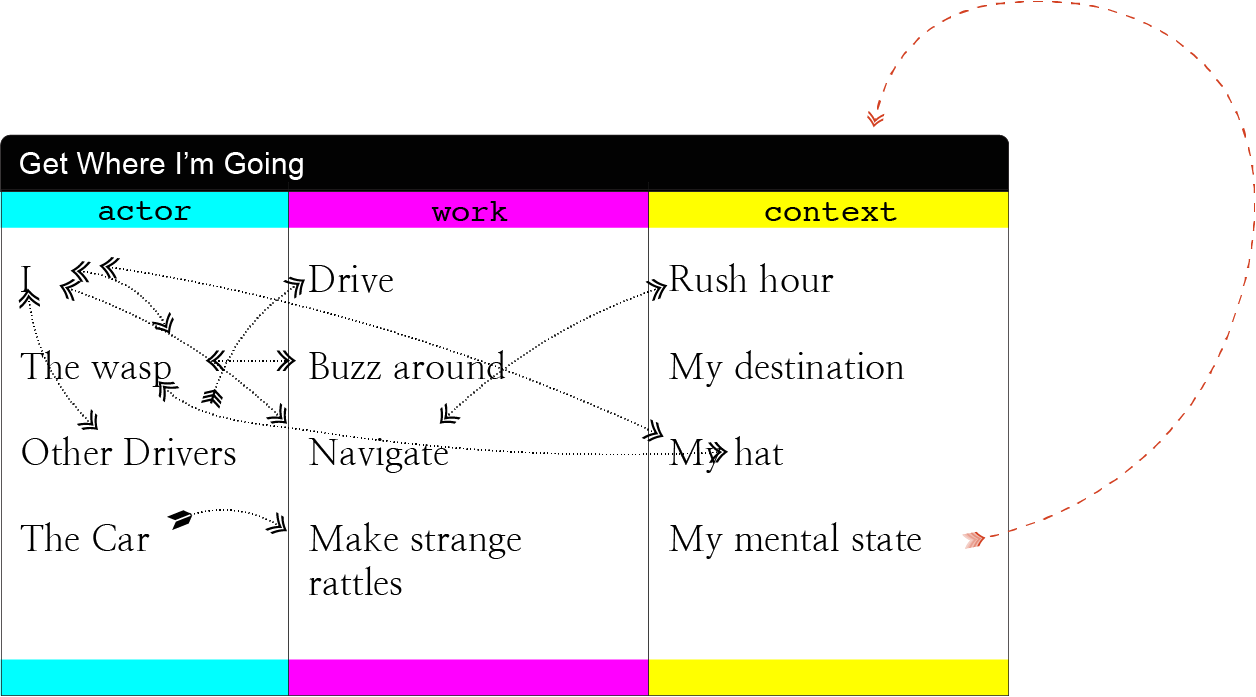
Caption: Our straighforward story, “Just drive the car to your destination,” no longer captures the important parts of our experience in a meaningful way. So there’s no point in trying to force yourself into that story.
But until you have a direct story to follow about what you’re doing, you really can’t do either kind of work without the other. Your labor is changing itself as you do it.
That’s what conceptual labor is! It’s when you have to work with and on your story factory at the same time.

Sometimes, if you do enough conceptual labor you’ll get back to a basic sentence.
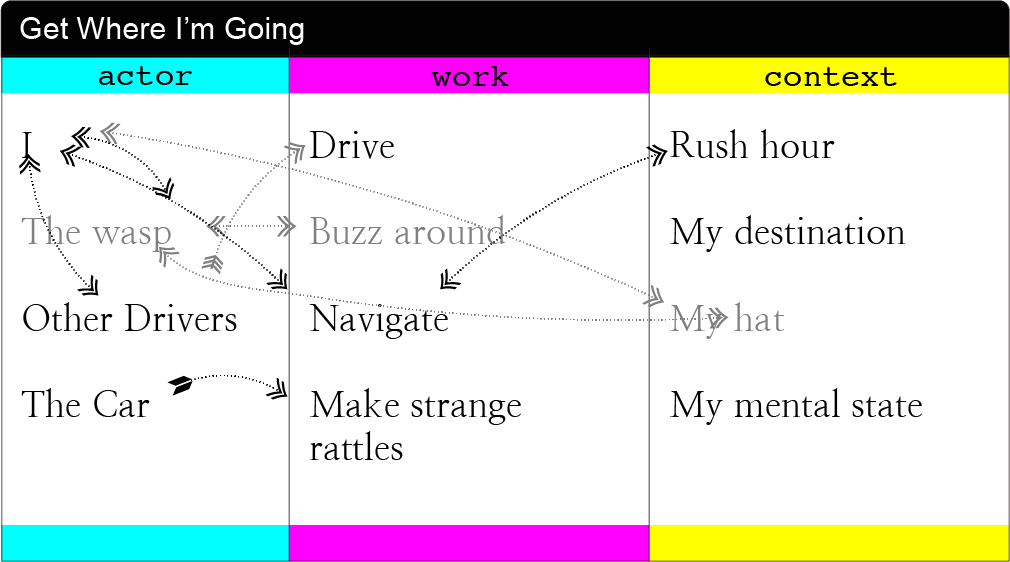
As your model changes, you can start to tell a simple story again.
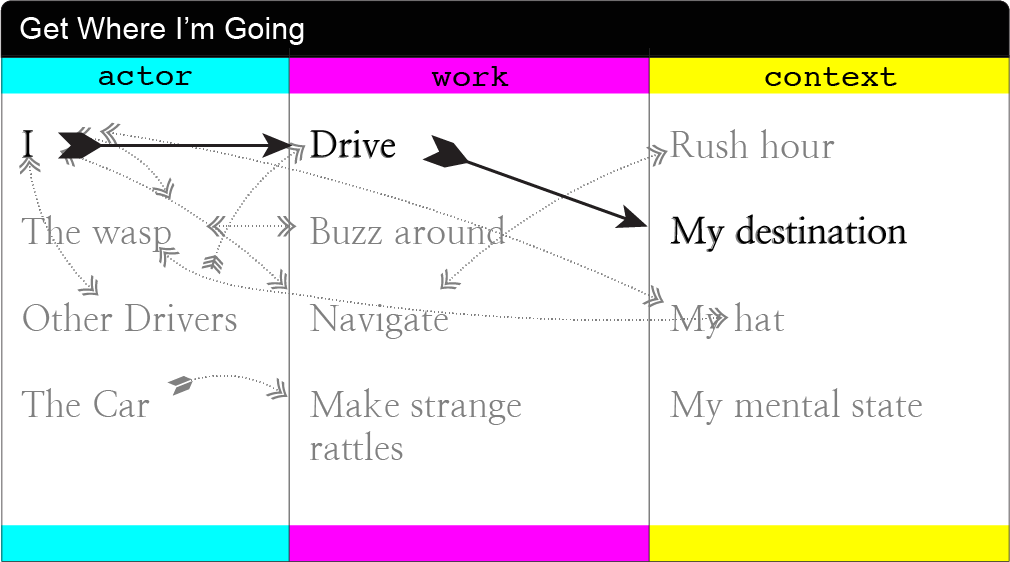
If your work never gets this simple, it’s nice to have a strategy that you can keep using as things keep changing.
And it’s nice to have a name for what you’re doing.
Models are free, and fast! We can imagine, change, and discard models waaay faster than we can write them down. Thinking about and writing about models can feel really rigid, because we’re slowing down that process to look at it. So, in reading the Theory, don’t forget that models can be huge or tiny in scope, extremely precise or very fuzzy and irrational, clearly described or entirely non-verbal. Models contain models contain models, and we swap and juggle them all the time.
All the Big Ideas, Put Together
The Theory is a set of ideas about this kind of work that, if you keep them in mind, should help you get to a strategy like that and keep it up to date as things keep changing.
Big Ideas #0 - 7
So the idea that we experience work through a story is like idea #0 –
0. Our experience of work is more like a story we tell ourselves than a set of instructions. We call this Labor.
So, starting there, the following seven ideas comprise the Theory:
- We can describe our labor using three basic categories: work, actors, and context. These are the significant things that are done, who or whatever is doing them, and the significant circumstances in which they are done.
- Whatever the “real work” is, the story we tell ourselves or others about our labor is what matters.
- We can’t tell a simple story in which the “real work” is clear to everyone involved if parts of that story in all three categories are connected and changing.
- When our labor is confusing like that, we will work towards goal of having a solid description of the job so we can “just do our work”.
- But as long as #3 is the case, we have to continue defining and redefining our labor.
- While that is the case, we will have to also do the work of understanding and justifying new terms, approaches, and work.
- We can learn what to do in unknown situations by working on specific problems that teach us how to work when labor is confusing.
You can read them in their official form here.
What it implies
All these ideas taken together become a sort of philosophy about work, or a certain perspective on it. You are meant to draw your own conclusions by applying it to your own work, but the book goes into some of the bigger implications. These are the Core Concepts that come from the Tenents.
They’re in a logical order in the Theory, but here are some of them in an order a more like what people I’ve talked tend to notice them:
- Stuff that doesn’t look like work might actually be really important work (and vice versa).
- What you focus on defines your experience of work (your labor) – so the model for one big job might have lots of little models inside it. The one that matters at any given moment is the one that you’re paying attention to. This can change your definition of “real work” really fast.
- The idea of “valuable effort,” at a fundamental level, is socially-constructed enough that it needs to be constantly negotiated.
- Listening to Laborers is not just good for them, it’s good for the process.
- If you have expertise in what you’re doing, the way you work probably doesn’t look like work to non-experts, so part of your job is explaining your work.
- When we’re leaning something, we go back and forth between being a non-expert and an expert.
- Labor feels easier if you can recognize when it’s conceptual labor and when it’s conventional.
- A lot of methods of doing conceptual labor are portable because they’re defined more by how you think about your work than how the outside world describes it.
- Some problems can only be solved by changing what and how you’re doing, even if it means stopping what you’re supposed to be doing.
- Of course, there are a million other ideas out there that say this one too – from cliches to whole methodologies. The Theory is is just trying to a be a thorough, reliable guidebook to turn to.
Maybe this doesn’t seem like that big of a deal but once you start looking for these ideas in the work you do or the work that affects you, I bet you’ll start seeing them everywhere. Entire jobs and industries are built in ways that match up to the theory. Job descriptions are written to try to keep stories simple and repetitive, people get paid less when their conceptual labor isn’t recognized – the list goes on!
Examples of things we can call “conceptual labor”
- Figuring something out on a computer by being reminded of how you figured out something similar in the physical world.
- Using expertise to approach work in the best way.
- Figuring something out with your hands.
- Everything that leads up to and follows the moment where you say “ok, here goes nothing” to yourself.
- The effort of learning a new skill until it becomes second-nature
- Creating an analogy that you need to understand something.
- The effort to describe something in terms someone else will understand.
- The effort to realize that what you’re doing isn’t effective, making yourself take a break, and re-evaluating work when you return to it.
How to Read the Book
The book is kind of a textbook for introducing the Theory of Conceptual Labor. Like a textbook, it takes some work to fully understand, and assumes that you have a motivation to do that work. I’ve tried to make it as readable as possible, but it does get a little dry at times!
First, it goes through the nuts and bolts of the Theory step by step.
Then it introduces some ideas about why it’s worth learning, and why it’s important. This section skims over a lot of big ideas from other fields, and could easily be its own book if it went into detail about all of them. Hopefully some of those ideas will overlap with your interests, so you can relate your own knowledge and expertise to the rest of the book.
Likewise, the next section introduces a method for applying the Theory. First it goes through an imaginary scenerio step by step, then it relates those steps to some real-world examples of hard work where the definition of “real work” is hard to pin down, and important to the people doing it.
The last section takes a similar approach to each Tenet of the Theory. It goes through the major ideas of the Theory and their most important implications one by one, abstractly at first and then again relating them to real-world circumstances.
If you’re skeptical about the Theory, or if just reading the nuts-and-bolts doesn’t make a lot of sense right away, this might be the best section to start with.